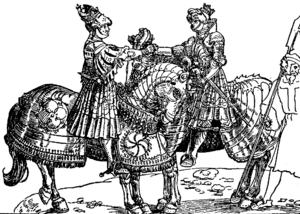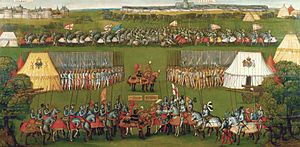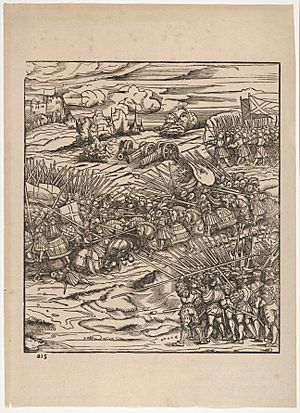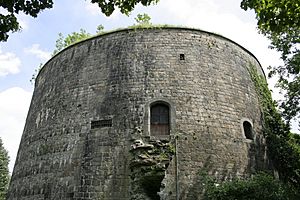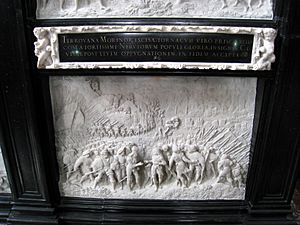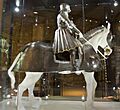Battle of the Spurs facts for kids
Quick facts for kids Battle of the Spurs |
|||||||
|---|---|---|---|---|---|---|---|
| Part of the War of the League of Cambrai | |||||||
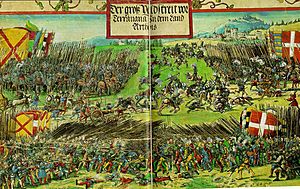 Triumphzug Kaiser Maximilians, Georg Lemberger |
|||||||
|
|||||||
| Belligerents | |||||||
| Commanders and leaders | |||||||
| Strength | |||||||
| 30,000 overall, many fewer were engaged | 7,000 | ||||||
| Casualties and losses | |||||||
| Light | 3,000 killed, wounded, captured, and missing | ||||||
The Battle of the Spurs was a major fight that happened on August 16, 1513. It is also known as the Day of the Spurs (Journée des éperons) because French soldiers fled so quickly. This battle was part of the War of the League of Cambrai, which was a bigger conflict called the Italian Wars.
During this time, King Henry VIII of England and Emperor Maximilian I were trying to capture the town of Thérouanne in France. French soldiers tried to bring supplies to the town, but English and Imperial (German) troops surprised them. The French cavalry (soldiers on horseback) ran away very fast. Many important French leaders were captured. After Thérouanne fell, Henry VIII went on to capture another French town called Tournai.
Contents
A Time of War
Joining the Holy League
In 1511, King Henry VIII joined a group called the Holy League. This group included Venice and Spain. Their goal was to protect the Pope and fight against France. Henry promised to attack France with 10,000 soldiers.
In 1512, Henry sent an army to France. It landed in the Basque Country. The army stayed there for a few months, but it didn't have enough supplies. Emperor Maximilian joined the Holy League later that year. France hoped that Scotland would help them fight against England.
The Siege of Thérouanne
In May 1513, many English soldiers arrived in Calais. They joined an army led by George Talbot. King Henry VIII decided to lead the invasion himself. He arrived in Calais on June 30 with 11,000 men.
The army had many types of soldiers. There were cavalry (horseback soldiers), artillery (cannons), infantry (foot soldiers), and longbowmen. The longbowmen used special arrows with steel tips to pierce armor.
The English army began to attack Thérouanne. They used cannons and dug tunnels under the walls. But the French and German soldiers inside the town fought back hard. The town was defended by Antoine de Créquy. He kept firing cannons, and the English called one of his shots the "whistle."
King Henry set up his camp east of Thérouanne. It was well-protected with cannons and strong defenses. Henry's own tent was a wooden cabin with a chimney. It had large, colorful tents around it, decorated with symbols like the Lion and the Dragon.
Emperor Maximilian arrived in August with a small group of soldiers. Henry met him on August 11. Henry wore light armor, and his group wore fancy gold clothes. Maximilian's group was still wearing black because his wife had recently passed away. Henry hosted Maximilian in a special tent. The weather was very bad that day. Queen Catherine of Aragon was happy about the meeting. She thought it would make Maximilian look stronger.
The French king, Louis XII, wanted to break the siege. In July, a group of 800 Albanian soldiers managed to get through the English lines. They delivered gunpowder and food to the town. This made the English suffer some losses. The French hoped the town could hold out longer.
The Battle
French Plan to Supply Thérouanne
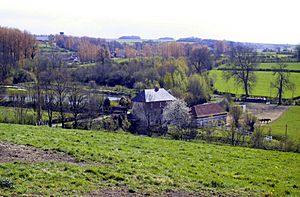
On August 16, the French tried again to supply Thérouanne. They gathered an army south of the town. This army included gendarmes (heavy cavalry) and pikemen (soldiers with long spears). They also had "stradiots," who were light cavalry. These stradiots were likely Albanian units. They rode with short stirrups and carried light lances and Turkish swords.
The English had built five bridges overnight over the River Lys. This allowed their army to move easily. Henry moved his camp to Guinegate on August 14.
The French divided their heavy cavalry into two groups. One group was led by La Palice and Louis, Duke of Longueville. The other was led by Charles IV of Alençon. Both groups were meant to distract the English. This would allow the stradiots to reach Thérouanne with supplies. Each stradiot carried bacon and gunpowder for the town.
The Fight Begins
The French hoped to surprise the English by moving before dawn. But English scouts, light cavalry from the Scottish borders, spotted them. King Henry VIII quickly gathered his forces. He sent out 1,100 cavalry, followed by 10,000 to 12,000 foot soldiers.
La Palice's French force met the English scouts near the village of Bomy. The French realized the English were ready. They stopped on a hillside. The stradiots then tried to reach the town in a wide circle.
Historians have slightly different accounts of what happened next.
According to one account, La Palice stayed in his exposed position too long. He wanted to give the stradiots the best chance to succeed. The English heavy cavalry lined up in front of him. English archers on horseback got off their horses and shot at the French from a nearby hedge. La Palice finally ordered his troops to retreat.
Just as the French began to move, the English cavalry charged. This threw the French into confusion. To make things worse, the stradiots, who had been turned back by cannon fire from the town, crashed into the side of the French cavalry. At the same time, some Imperial cavalry also arrived, threatening the other side of the French horsemen.
Panic spread among the French cavalry. Their retreat turned into a wild flight. La Palice tried to stop them, but it was no use. To escape faster, the French threw away their lances and flags. Some even cut off their horses' heavy armor. The chase lasted for miles until the French reached their foot soldiers at Blangy. Many important French knights were captured, including La Palice himself.
Another account says that Emperor Maximilian planned the battle. He suggested sending troops to the sides and rear of the French. He also advised putting cannons on a nearby hill. Maximilian himself led 2,000 cavalry troops. He charged the French as soon as they met. The French cavalry fought back at first, but then quickly gave way and ran. Some say the French retreat was a trick to let the Duke of Alençon supply the city. But the Duke was stopped before he reached the town. The retreat became a disaster that the French commanders could not control.
Why "Battle of the Spurs"?
The day was quickly named the "Battle of the Spurs" (in French: La Journée d'Esperons). This was because the French horsemen used their spurs so much to flee the battlefield. In 1518, an English ambassador joked that the French had learned to ride fast at the "jurney of Spurres."
King Henry VIII sent his own report of the battle the next day. He said the French cavalry first attacked the English blocking the town. They captured 44 men and wounded 22. But then the Imperial cavalry moved, bringing the French within range of the cannons. The French cavalry then fled.
The English writer Edward Hall also wrote about the battle. He said the French cavalry broke after the English showed their banners. Hall mentioned that Maximilian advised Henry to use some cannons on another hill, but he didn't say it changed the outcome much. Henry wanted to lead the charge, but his advisors told him to stay with the foot soldiers.
After a chase of three miles, many French leaders were captured. These included Jacques de la Palice, Chevalier de Bayard, and Louis d'Orléans, Duke of Longueville. During the fighting, the soldiers inside Thérouanne also attacked the English. Reports say three English soldiers were killed, and 3,000 French soldiers were killed, wounded, or captured. The English captured nine French flags and 21 noble prisoners.
After the Battle
Thérouanne Falls
On August 20, with no more French attacks, Henry moved his camp closer to Thérouanne. The town surrendered on August 22. The French and German soldiers inside the town gave up because they had no more supplies.
The English soldiers then began to tear down the town's walls and three large forts. They pushed the stones into the deep ditches around the town. On September 5, the Pope was told about the English victories and sent his congratulations.
Siege of Tournai
While Thérouanne was being destroyed, the English and their allies decided to attack Tournai. Henry would have preferred to attack Boulogne, but they chose Tournai. Henry entered Lille with a grand ceremony on September 10. That evening, Henry played music and danced until almost dawn.
The army began to attack Tournai on September 10. Henry VIII was worried because Scotland was preparing to invade England to help France. But the Scottish army was defeated at the battle of Flodden on September 9. Before Tournai fell, Queen Catherine of Aragon sent Henry the blood-stained coat of the Scottish king, James IV. She suggested Henry use it as his battle flag.
Tournai surrendered to Henry VIII on September 23. The people of Tournai had tried to defend their town. They burned their suburbs and ordered women and children to repair the walls. But they eventually decided to negotiate with Henry.
Henry attended a church service in Tournai Cathedral on October 2. He knighted many of his captains there. Tournai remained under English control for a few years. New forts were built, costing a lot of money. But in 1518, Tournai was given back to France as part of a peace treaty.
Celebrating the Victory
Henry and Maximilian published a book about their victories. It described their meeting and the battle. The book included woodcuts (old prints) of their meeting and Maximilian in battle. The Battle of Guinegate was described as a quick flight by the French.
An Italian poem about the fall of Thérouanne was printed in Rome in September 1513. Maximilian also ordered woodcut images of his meeting with Henry. Henry ordered paintings of the meeting and the battle. These paintings showed him in the middle of the action, even though he stayed with the foot soldiers.
Maximilian wanted to destroy the walls of Tournai. This would stop France from using it as a base to threaten his grandson's lands. He worked with Thomas Wolsey, who was an important English advisor. Wolsey was promised a high church position in Tournai. Henry VIII and Queen Catherine were very grateful for Maximilian's help. They later sent him a large sum of money.
After the battle, many English soldiers were made knights. This was a special honor for their bravery.
Images for kids
See also
 In Spanish: Batalla de Guinegate (1513) para niños
In Spanish: Batalla de Guinegate (1513) para niños


